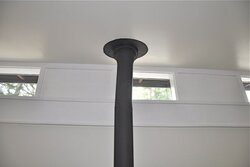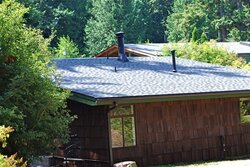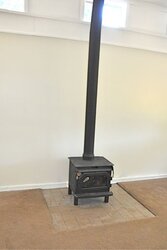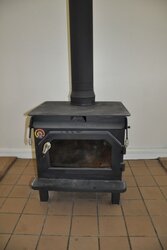Hello, everyone. I'm new here and completely new to wood stoves-- I've never used one before. I did read this site's FAQ's before posting.
I inherited a wood stove in a rental cabin I purchased. I imagine the stove is twenty years old or so. I paid a chimney sweep to clean the chimney two years ago and I bought a chimney brush and swept the chimney again this summer. I have a new tenant in there who is having some issues. During a very light rain, mostly fog and mist, he complained of some water dripping down the outside of the stove pipe onto the stove top. We just re-roofed this summer and the boot and gaps and everything looks watertight from above. During the light mist we climbed up on the roof. The top hat above the chimney is in excellent condition. We removed the top hat off the chimney top on the roof and the interior of the stove pipe up there was definitely slightly wet/damp. Could this be condensation from wet moist air? Does a little water sometimes run down on the outside of the stove pipe in the house?
The tenant is also complaining that some soot is falling down the stove pipe onto the top of the stove. So I have some gaps in the stove pipe that a small amount of soot is escaping from. Is a little soot normal? These issues are not life threatening, or are they??!! Should I tell him to chill or what do I need to do?
Also if you inherited a 20 year old wood stove, are there other things I should check or maintenance work I should perform beside chimney cleaning? Thank you for helping the newbie today. I tried to post some photos below, not sure if this board will allow me to link or add attachments. Thanks.
I inherited a wood stove in a rental cabin I purchased. I imagine the stove is twenty years old or so. I paid a chimney sweep to clean the chimney two years ago and I bought a chimney brush and swept the chimney again this summer. I have a new tenant in there who is having some issues. During a very light rain, mostly fog and mist, he complained of some water dripping down the outside of the stove pipe onto the stove top. We just re-roofed this summer and the boot and gaps and everything looks watertight from above. During the light mist we climbed up on the roof. The top hat above the chimney is in excellent condition. We removed the top hat off the chimney top on the roof and the interior of the stove pipe up there was definitely slightly wet/damp. Could this be condensation from wet moist air? Does a little water sometimes run down on the outside of the stove pipe in the house?
The tenant is also complaining that some soot is falling down the stove pipe onto the top of the stove. So I have some gaps in the stove pipe that a small amount of soot is escaping from. Is a little soot normal? These issues are not life threatening, or are they??!! Should I tell him to chill or what do I need to do?
Also if you inherited a 20 year old wood stove, are there other things I should check or maintenance work I should perform beside chimney cleaning? Thank you for helping the newbie today. I tried to post some photos below, not sure if this board will allow me to link or add attachments. Thanks.





